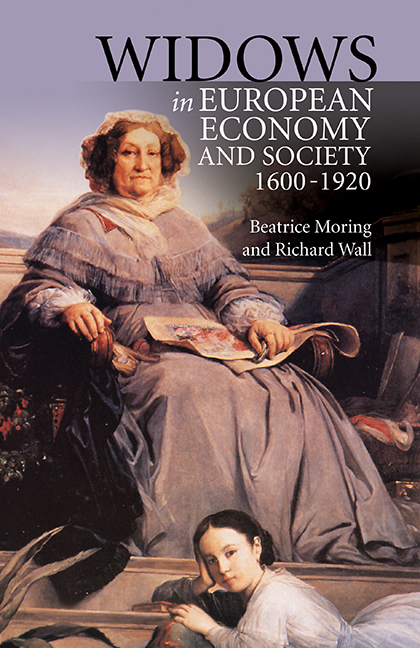Book contents
- Frontmatter
- Contents
- List of Plates
- List of Tables
- Acknowledgements
- Introduction
- 1 Widows and Poverty
- 2 Widows, Legislation and Property
- 3 Assessing the Assets of the Widow
- 4 Life Interest, Usufruct or Pension, The Mainstay of the Widow?
- 5 Urban Widows, Economy and Family
- 6 The Demography of Widowhood
- 7 Household Structure, Age, Social Status and Geography
- Conclusion
- Appendices
3 - Assessing the Assets of the Widow
Published online by Cambridge University Press: 30 August 2017
- Frontmatter
- Contents
- List of Plates
- List of Tables
- Acknowledgements
- Introduction
- 1 Widows and Poverty
- 2 Widows, Legislation and Property
- 3 Assessing the Assets of the Widow
- 4 Life Interest, Usufruct or Pension, The Mainstay of the Widow?
- 5 Urban Widows, Economy and Family
- 6 The Demography of Widowhood
- 7 Household Structure, Age, Social Status and Geography
- Conclusion
- Appendices
Summary
IN their summary of the contributions to the volume Widowhood in Medieval and Early Modern Europe, Cavallo and Warner underline the different positions of widowed women and men. While men continued their lives as before, at least in some parts of Europe, women had considerable difficulties in accessing and utilising the property and autonomy to which they were legally entitled. In their efforts to generalise, the experiences of noble widows from southern Europe are amalgamated with and believed to illustrate those of women from other social groups and geographic areas. The noble and propertied members of socio-economic élites are, of course, more easily traced in historical records. However, the struggle of noble women to control their property is likely to provide a poor guide to the experiences of women of less lofty status. Many widows with access to property would have been of ‘the middling kind’, rather than the highest in the land.
While we might find that widows in general were not the holders of large property portfolios, it would seem that many husbands trusted the ability of their wives to hold on to their houses, holdings and small businesses and take care of the children as well as provide for their future.
The aim of the present chapter is to examine the economic situation of widows using nominative data like wills, inventories and taxation. One of the issues that will be discussed is the difference between men and women in the amount and type of property that they owned. Another is to what extent transfers were linked to legislation or provisions in wills. Some efforts will also be made to compare the inventories of widows with those of old men, instead of all men, to gauge the effects of life transitions. When equal stocktaking was done at the end of life, were women seriously disadvantaged?
Widows, Taxation and Real Property
Studies of property transfers in early modern Europe have revealed that, in certain regions, half of the widows received land or house property when their husband died, but in other areas, little is known about landed property.
- Type
- Chapter
- Information
- Widows in European Economy and Society, 1600-1920 , pp. 81 - 118Publisher: Boydell & BrewerPrint publication year: 2017

